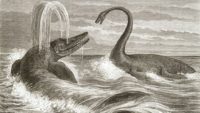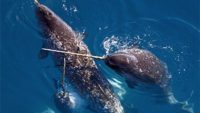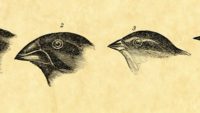By Dr. Danny R. Faulkner What’s up in 2019? The year begins with a bang, for on the morning of January 1, the moon and Venus will be close together in the sky. …read more Source: AIG Daily
A Polish research duo described the remains of an elephant-size synapsid from upper Triassic rocks. Only it’s not supposed to be there. Secular reactions express shock at this turn from a longstanding evolutionary tale. Synapsids are commonly referred to as “mammal-like reptiles,” but were neither reptiles nor mammals. They were unique—the sail-finned dimetrodon was a synapsid. Like dinosaurs, … More… …read more Source: icr.org
By Dr. Don DeYoung There have been many attempts to explain the Christmas Star scientifically, and three will be mentioned here. …read more Source: AIG Daily
What does Grand Canyon tell us about the Genesis Flood? ICR geologist Dr. Tim Clarey uncovers the evidence and shares about his work with the ICR Discovery Center. Can Christians be confident about the origin of life? And what are genetic clocks? ICR geneticist Dr. Jeff Tomkins explains how genetic research confirms the Bible. Listen: Grand Canyon and Genetic Clocks Confirm the Bible | The Institute for Creation Research
By Ken Ham New research reveals ichthyosaurs, extinct marine creatures, likely had blubber, smooth skin, countershading, and were warm-blooded. Now that’s interesting and will certainly prompt scientists to take another look at this fascinating creature. But the real story here is one you have to read between the lines to get. Johan Lindgren, the lead researcher on this study published in Nature, states of the find: This animal’s preservation is unusual, especially for a marine environment . . . This specimen has given us more evidence that these tissues and molecules can preserve for extremely long periods, and that soft [More]
Does CMI just bash evolution? Learn about both the positive and negative arguments in biblical apologetics. …read more Source: creation.com
When it comes to explaining how our universe came into being, widespread speculation is embraced over hard evidence. …read more Source: creation.com
The lovable, designed gecko makes the news again this year.1 In 2009, it was discovered the gecko had amazing nocturnal vision.2 Even their sophisticated feet that secrete phospholipids, complex membrane molecules, are a wonder of creation.3 The impediment of directional hearing in small animals, such as the gecko, is cleverly solved by the Creator’s design. In larger creatures, … More… …read more Source: icr.org
It does not add up for the evolutionary story. …read more Source: creation.com
A research team described a form of fossilization that it thinks can explain how original proteins have lasted for millions of years in Earth’s crust. It does match certain fossil features, but leaves two key questions unanswered. And that leaves soft tissue fossils still looking quite young. Publishing in Nature Communications, Yale University scientist Jasmina Wiemann and colleagues drew two parallels… More… …read more Source: icr.org
By Dr. Joe Francis The narwhal’s unusual tusk clearly didn’t grow by accident—but what is it there for? …read more Source: AIG Daily
By Dr. Danny R. Faulkner Flat-earthers argue that since certain verses in Scripture speak of the stars falling, then the stars will literally fall. …read more Source: AIG Daily
Experimenting on humans, especially at the earliest stages of life, raises all sorts of ethical problems. From IVF to human cloning, people have debated the morality of tampering with people, who might then suffer consequences from the experimentation throughout their lives. CRISPR (clustered regularly interspaced short palindromic repeats), a gene-editing technology that has made genetic manipulation easier and less expensive than ever before, holds both the promise of a cure for diseases that are currently fatal, and the threat of opening a Pandora’s box of unintended consequences. Source: Genetically modified babies – creation.com
Large natural bridges and freestanding rock arches are structures left behind after erosive action, features called erosional remnants. Along with several other types of landforms examined in this magazine in recent years, they provide further evidence for rapid erosion in the late stages of Noah’s Flood. Read More: The puzzle of large natural bridges and freestanding arches – creation.com
The media often give the impression that evolution is scientific because scientists can tell us how it happened. In reality, the supposedly ‘factual’ accounts of where the universe came from and how the earth’s plant and animal life evolved are no more than imaginative stories. When pressed for details, the more honest scientists will sometimes admit that they really don’t know. The big bang According Professor Brian Cox, “You cannot claim that there wasn’t a big bang because you can see it”.1 Here he is not referring to the big bang itself, but what he believes to be [More]
Plankton is a generic term for small marine creatures such as algae, bacteria, and protozoa. Although tiny, they are packed with incredibly intricate submicroscopic structures. This complexity isn’t surprising since many of these entities are photosynthetic, able to turn light energy into sugars needed for life’s energy. This process of photosynthesis is surprisingly complex. Bacteria and single-celled alg… More… …read more Source: icr.org
Response to a correspondent who had taken a CMI writer to task, claiming that 14C, dendrochronology, and uranium-thorium (U-Th) dating techniques are trustworthy. …read more Source: <a href=http://creation.com/carbon-dating-fooling-who target=_blank title="Carbon dating-who is fooling who?” >creation.com
Contrary to the well-known intelligent-design claim that some biological systems are so complex that they must have been designed, botanist and environmental scientist Alexander Williams has now described a new concept that shows all aspects of life point to intelligent design. ‘This concept is simpler, and broader in its application, than Behe’s concept of irreducible complexity’, Williams says, ‘and it applies to all of life, not just to some of it.’ Writing in the latest issue of the Journal of Creation, Williams outlines the biological concept of autopoiesis, a term that literally means ‘self-making’. Autopoiesis refers to the [More]
By Harry F. Sanders, III It’s commonly assumed that mutations associated with genetic diseases and cancers occur because they disrupted otherwise ordered proteins, but is this the case? …read more Source: AIG Daily
Evolutionists stopped in their tracks as amber find has them scratching their heads. …read more Source: creation.com
What’s an ‘animal-only’ pigment doing in plants? …read more Source: creation.com
This miniature underwater Christmas tree shows how wonderfully God blends the beautiful with the practical. …read more Source: AIG Daily
By Ken Ham The ice age, a time of wooly mammoths, saber-toothed cats, and glaciers, may seem like a great mystery. But it’s not a mystery when we start with the history found in God’s Word. Indeed, that history actually explains how an ice age is even possible—in a secular worldview it’s very difficult to explain one ice age, let alone the many that secularists believe in. Now, you may be wondering what the Bible says about the ice age. Well, the Bible doesn’t specifically tell us there was an ice age, but we can observe today that there was [More]
Evidence for creation is seen in both the sudden origin1 of spiders, as demonstrated in the fossil record, and their amazing design.2 All spiders are created with four pairs of walking legs. Spider fossils are rare. Only about a thousand fossil species have been described worldwide. But they always display their iconic eight legs, remarkably complex eyesight organs and are, as creationists predict, 100% spiders. The Ju… More… …read more Source: icr.org
By Dr. Jason Lisle Randy Guliuzza has made some controversial claims regarding the cause and nature of adaptation of organisms to their environment. We examine his claims. …read more Source: AIG Daily
Salamander-like footprints preserved in sandstone have long fascinated Grand Canyon hikers and rafters. Insights from a new study of the track patterns intensify an old trackway mystery. But Noah’s Flood can help solve this mystery. It boils down to this: How could a four-footed track maker leave so many details of its foot if it was walking on windblown sand dunes? Footprints in dry sand leave shapeless divots … More… …read more Source: icr.org
By Dr. Don DeYoung Even mathematicians—studying the rules that underlie reality—are tied up in knots over the surprising twists of “knot theory.” …read more Source: AIG Daily











































